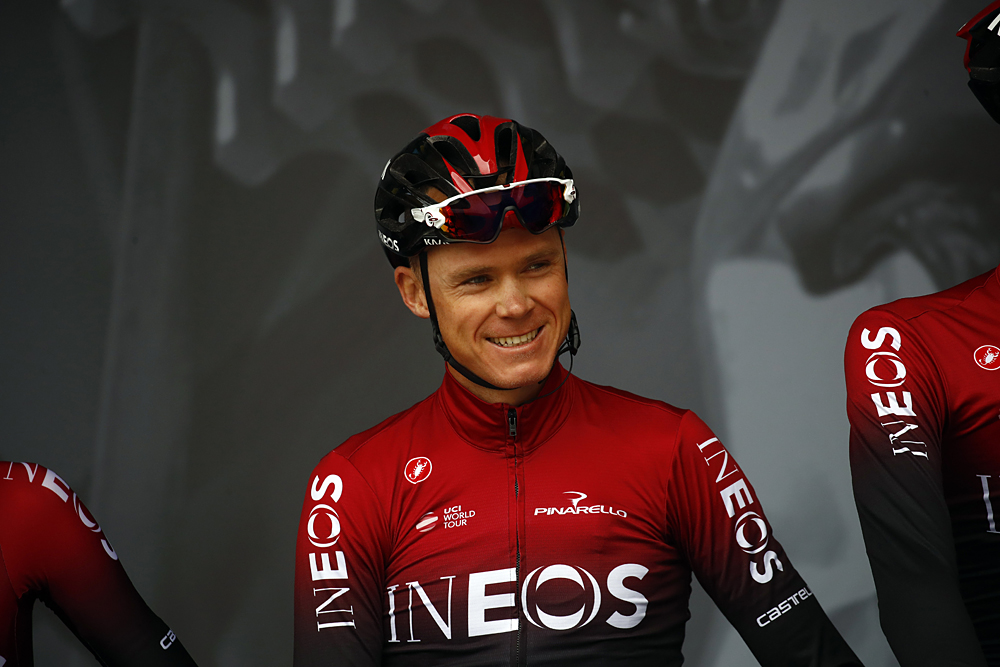Chris Froome targets 2020 Tour de France as he continues rehabilitation
Briton says recovery from injuries sustained in Dauphiné crash is 'ahead of all the predictions'

Chris Froome has set himself the target of competing in the 2020 Tour de France as he continues his rehabilitation from the injuries that ruled him out of this year’s race.
Froome sustained a broken femur as well as fractures to his hip, elbow, sternum and vertebrae when he crashed while reconnoitring the stage 4 time trial at Critérium du Dauphiné in June. The Briton spent more than three weeks in hospital but during the final week of the race, he posted a video to social media which showed him pedalling with one leg on a turbo trainer.
On Saturday, Team Ineos posted a longer video interview with Froome, who described the early stages of his rehabilitation and outlined his intention to return in time for next year’s Tour. Froome’s Ineos teammate Egan Bernal won the 2019 Tour, with Geraint Thomas placing second overall. It was the British team’s seventh Tour win in eight years, a sequence that began with Bradly Wiggins’ 2012 victory and continued with Froome’s four victories.
“The only goal I’ve set myself personally is to get to the Tour de France next year, that’s what’s driving me,” Froome said in the video. “Week by week, I can set myself little goals in terms of allowing myself more movement, but for me, the underlying goal is to get to the start of that Tour de France next year, in 2020, and be at a similar or better position to this year. That’s what’s driving me at the moment.”
Froome has not spoken to the press since his crash on June 12 – “It just felt as if I needed a bit of time for myself and a bit of time to come to terms with what had happened” – but he described his recollections of the incident in Saturday’s video for Team Ineos.
“I can remember the first part of the recon but around where I crashed, I’ve got no recollection at all, so I can only really go off what people who saw the crash happen and what they said,” Froome said. “What I understand is that it was a perfectly straight piece of road, slightly downhill, so I was going at quite a bit of speed. And I went to go and clear my nostrils and I was also going past some buildings at the same time. The wind funnelled through some buildings and took my front wheel. I tried to hold it up and I ended up veering off the road and into a wall at quite high speed. I think it was really just one of these freak, freak accidents.
“I can remember lying on the road and the first responders coming over to me, and my coach Tim Kerrison, my mechanic Gary Blem and Servais Knaven my director, they were all in the car behind me. I can remember interacting with them, speaking to them. I think my first question was, ‘Can I get up, can I get back on my bike, am I going to be ok?’ They made it very clear that I wasn’t moving anywhere, and I should just lie still, and I wouldn’t be carrying on the rest of the race.
Get The Leadout Newsletter
The latest race content, interviews, features, reviews and expert buying guides, direct to your inbox!
“I think one of my first questions was am I going to be alright for the Tour de France and they quickly put that out of my mind. They obviously didn’t give a prognosis, but they said, ‘It looks like your leg’s broken and your arm doesn’t look good either so no, you’re not going to be on your bike.’ I think those were the first moments that it hit home and I took it on board that I’m not going to be racing the Tour de France this summer. It almost felt like a scene from Grey’s Anatomy or something, where it just hit home that there was more going on.”
Froome would spend more than three weeks in hospital in Saint¬-Étienne but he was heartened by some early feedback from his surgeon, who told him that he could make a “100% recovery.” In the weeks since, Froome has begun his rehabilitation programme at his home in Monaco, and he said that he was already ahead of schedule.
“I think it’s safe to say I’m ahead of all the predictions that were made initially of how long it would take even just to get to this point. I got the green light to start weight-bearing - very lightly, but it’s something, it’s a big step,” Froome said.
“I’ve been doing 3-4 hours of physio every morning. I take a small break at lunch time and then I start the exercises I need to do, 2 hours on my own, just implementing everything that the physio has helped me to be able to do. The days are full.”